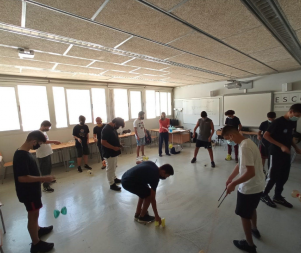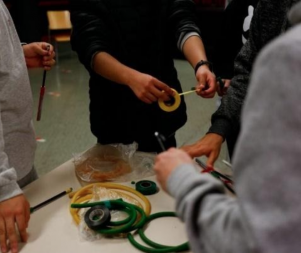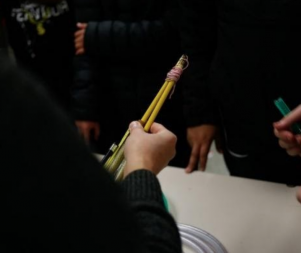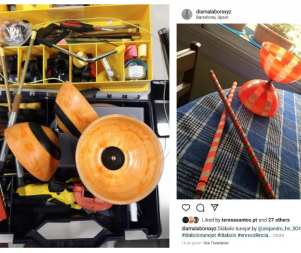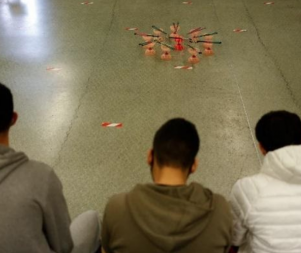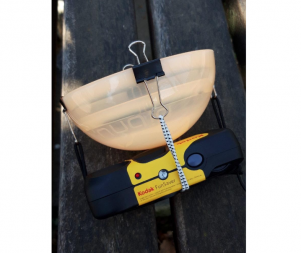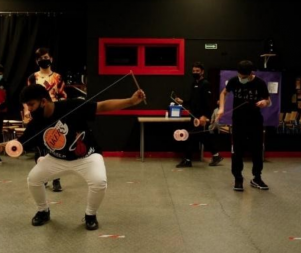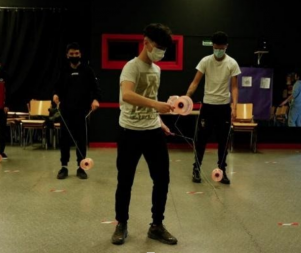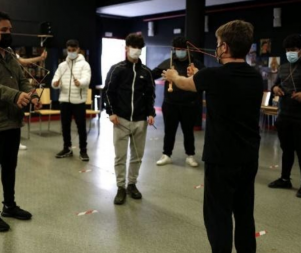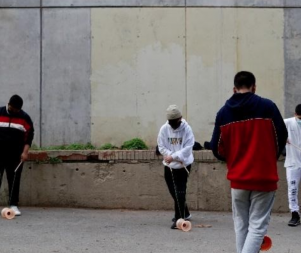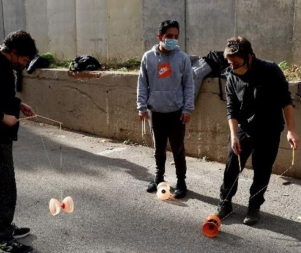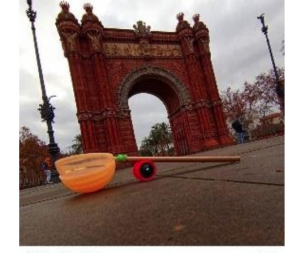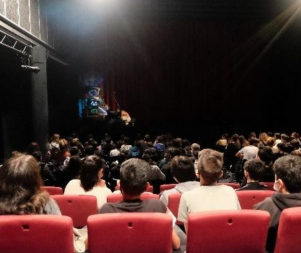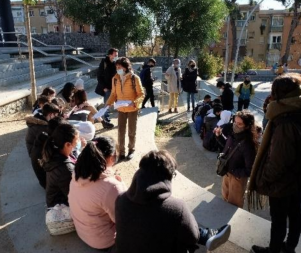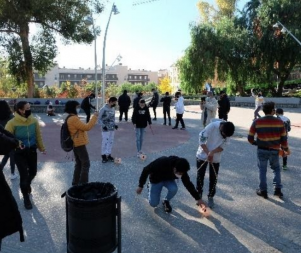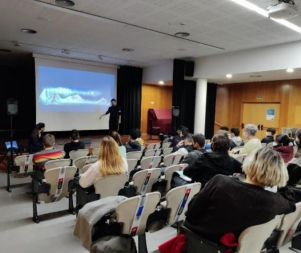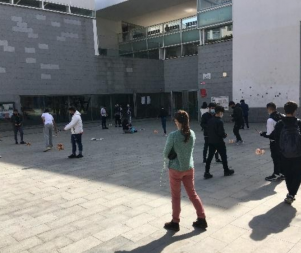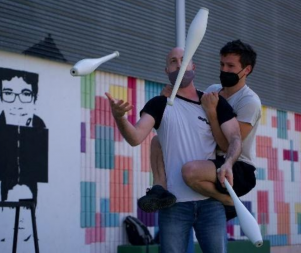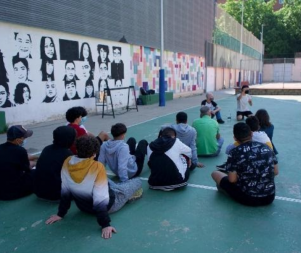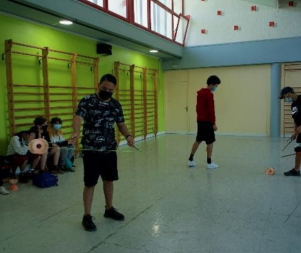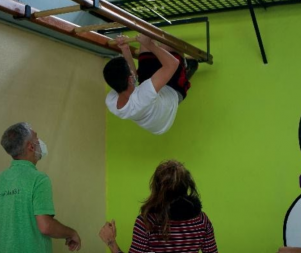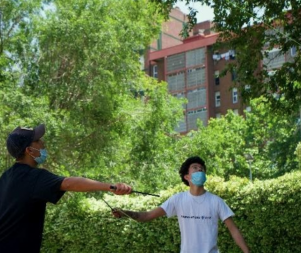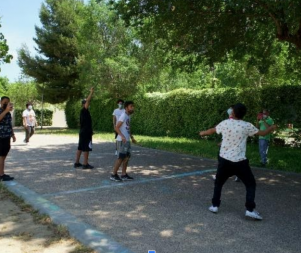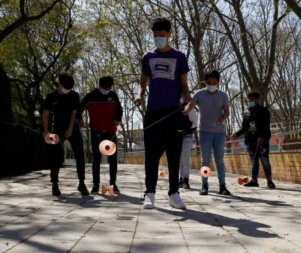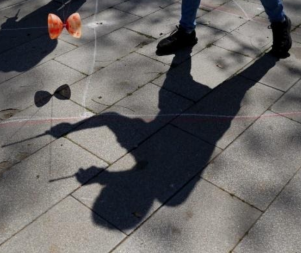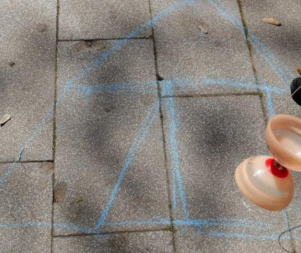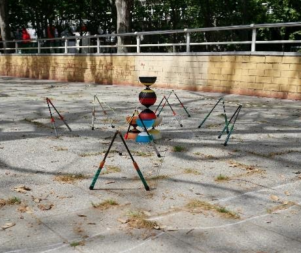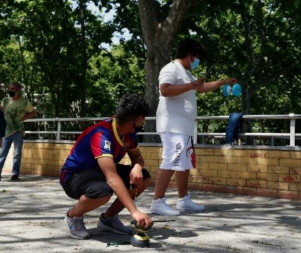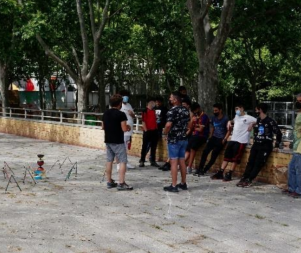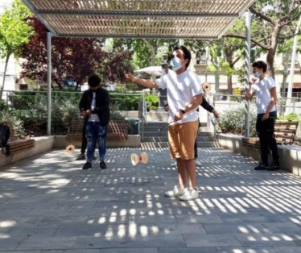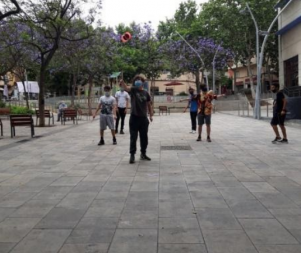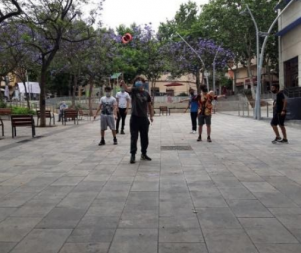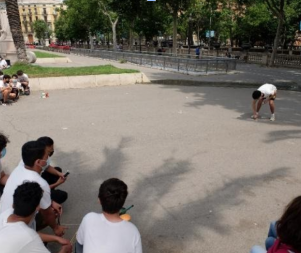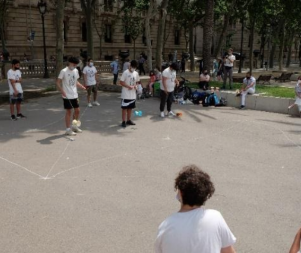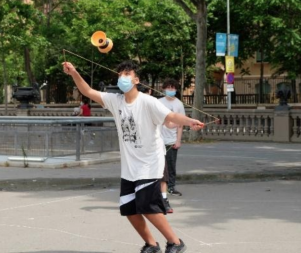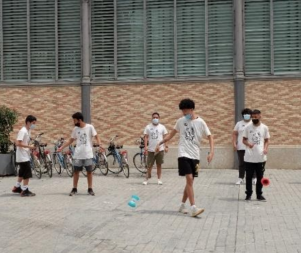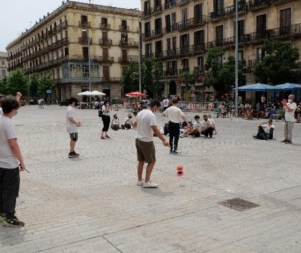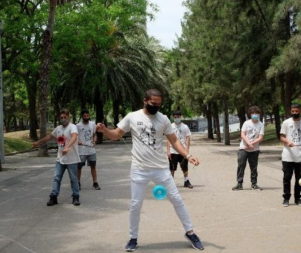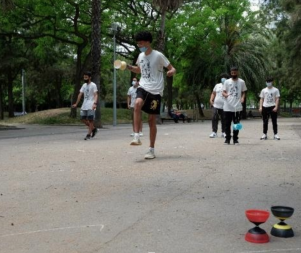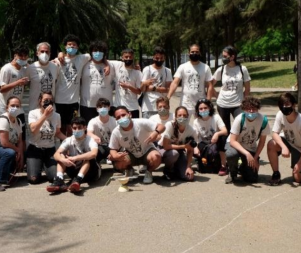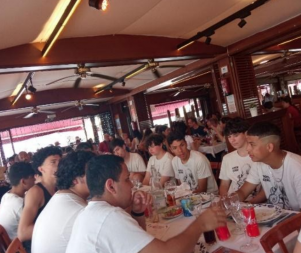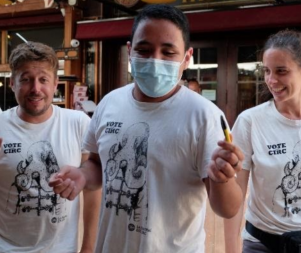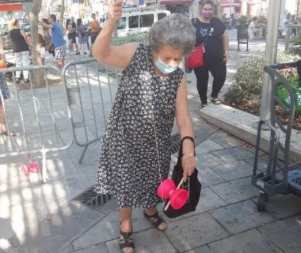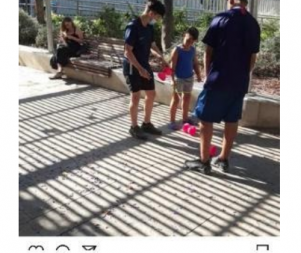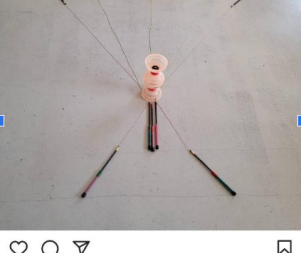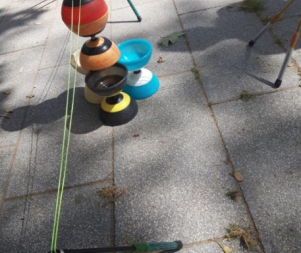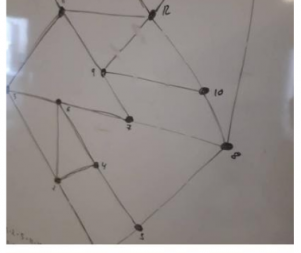- 14th EDITION 2022 / 2023
- 13th EDITION 2021 / 2022
- 12th EDITION 2020 / 2021
- 11th EDITION 2019 / 2020
- 10th EDITION 2018 / 2019
- 9th EDITION 2017 / 2018
- 8th EDITION 2016 / 2017
- 7th EDITION 2015 / 2016
- 6th EDITION 2014 / 2015
- 5th EDITION 2013 / 2014
- 4th EDITION 2012 / 2013
- 3rd EDITION 2011 / 2012
- 2nd EDITION 2010 / 2011
- 1st EDITION 2009 / 2010
Troposfera.xyz IN RESiDENCE at the School Josep Comas i Solà
LANDING
The Comas i Solà group from Aula Oberta was made up of only boys. This generated certain concerns about the internal dynamics and the type of artistic languages that they would use. During the first few weeks they carried out a project to get to know one another, to create a framework of trust, to explore spaces where they could do the activity, to research interests and references and to open up to the different artistic languages that they would use.
During these first sessions we have had the opportunity to get to know the class, to introduce ourselves and to reflect on the digital world by answering a questionnaire and breaking the ice with different objects, in order to arrive at juggling. We began learning basic juggling techniques with enthusiasm, as well as discovering the relationship between the body and objects through research; interpreting, observing and composing.
The digital networks are another space for creation and communication. At the beginning of the process there was a questionnaire to find out what digital tools they knew, whether they were producers or consumers. Using this information, Didac and Teresa created a task to open up to new tools, modifying those already known both for generating audiovisual content and for communicating, both internally and externally, what they were experiencing inside and outside the classroom.
- YouTube channel: https://www.youtube.com/channel/UCfxNIB5OSYEalbTQ_SYyVJQ
- Instagram account: https://www.instagram.com/diamalaborsxyz/?igshid=mtwfmvi772gh
- Troposfera.xyz blog: https://labs.troposfera.xyz/enresidencia/
- Apps and tools for editing: BeeCut for editing with mobile phones and VideoPad for editing with a computer
- And a server on Discord for communication.
CLASSROOM
The session from the other day began in the computer room, which at our school is called ART-TIC. Dídac and Teresa showed us how to start a session on the blog by creating our own profile, we also spoke about each one of us creating our own YouTube channel to publish our videos privately, because we do not want anyone to see them (until they are edited). They also showed us the editing program that we will use, DaVinci Resolve for PC and BeeCut for mobile, they are easy to use, there are many editing tools, including colour correction for videos, visual effects and audio post-production.
The juggling, especially the diabolo, and dance formed the vehicle for experimentation, creation and growth.
At the beginning of IN RESIDENCE we played a few games to familiarise ourselves with the diabolo and its parts. It was a lot of fun at the beginning, but later on we started doing things: tricks with the diabolo and juggling.
JUGGLERS
For the jugglers, the work element is something very personal, which adapts to the artist’s particular way of creating and handling. Therefore, they bought diabolos, which they personalised, and a workshop was organised on constructing sticks.
We were in class, when Didac and Teresa arrived and we headed off to the Trinitat Vella Civic Centre, where they gave us our diabolo, the diabolo that we would use during the course and for the IN RESIDENCE PROJECT. They showed us how to put them together and afterwards they told us that we could ‘tune them up’ anyway we liked.
CAMERA
The camera was introduced from the beginning and was incorporated into the dance and juggling, becoming another element of action. This allowed for a very organic recording of the process which involved the participation not only of the creators, but also teachers and students.
Another day we went to the Trinitat Vella Civic Centre, that day we did not do the diabolo or juggling but we did dance, it was not dancing as such, but it was related with body movements. We did orbits while we recorded each other. On the other days we saw two videos, one by Akram Khanah , and another by Israel Galván, who are both contemporary dancers.
There were also experiments with the analogue camera, taking photographs from “inside the diabolo”:
LOCATION
It was a Wednesday, a sunny day, we went to the Trinitat Vella park to take photos with a diabolo cup stuck to a camera. We were divided into two groups: Teresa took four students to take photographs of landscape elements using the diabolo-camera. Dídac stayed with the others practising diabolo tricks. With Teresa, we began by walking through the park taking photos at our own discretion.
The location was also an important issue. The work was done in several spaces: in the computer room, the classroom, in public spaces and at the Trinitat Civic Centre. Because of the COVID measures, it was necessary to find spaces outside the school in order to maintain the bubble groups. In practice, the work in the civic centre was very satisfying, and brought with it other relationships and opportunities.
We used different spaces: the classroom, outside the school and the civic centre. We would change depending on the characteristics of each session and the weather forecast.
THE PUBLIC SPACE
The use of the public space was a leitmotif in the creation process. In fact, the final performance recovered this idea and it was presented in different parts of the city of Barcelona.
We went out to do some practice with the diablo at iconic landmarks in Barcelona with some classmates and the teacher. First we went to Arc del Triomf to take our first photos and our first videos of the practices, we went down Passeig de Lluís Companys doing exercises on the diabolo as a chain until we reached parc de la Ciutadella to do more tricks, take more photos and more videos. In front of the Fountain and the lake in parc de la Ciutadella, we tried to do a video of everyone together with the diabolo with people coming in and going out of the shot, but we made lots of mistakes and we had to repeat the video again and again. We stopped in front of the Catalan Parliament to take some photos with the diabolo. But we did not want to do any tricks with the diabolo because the Mossos d’Esquadra [Catalan police force] were watching us. From parc de la Ciutadella we went down to the Barceloneta beach to take photos at Hotel W and record ourselves on the beach.
MASH-UP - LA CENTRAL DEL CIRC
MASH-UP - WINTER CIRCUS
MASH-UP - QUINZENA METROPOLITANA DE LA DANSA
MASH-UP - LAZUZ
MASH-UP - BESÒS NEIGHBOURHOOD
IMPROVS
COMPOSITIONS
REHEARSALS
MOSAIC
CLOSE
RESONANCES
CREATION
One of the most important issues of the process and of the circus creations is the formation of the group. Symbolically, giving a name and choosing an image, a logo, is one way to announce the group.
The name DIAMALBORS (a fusion of the words Diàbolo/Diamant+malabars in Catalan) was chosen after a reflection process and as for the logo, the aim was to explain the variation of cultures that formed the group.
The dramatic construction was based on hip-hop rap battling, performing a critical review of its structure.
On Wednesday, Dídac and Teresa gave us homework on rap battling or FMS (Freestyle Master Series): three positive things and three negative, and then, they created an improvisation to practice tricks.
In the construction of the performance space, there were experiments with the earth lines based on the idea of the Tangram game and giving shape to a mosaic in which the improvisations will be done.
Gradually they began to try out the improvisations within the structure marked out in chalk.
We were practising everyone’s entrance and what to do within the mosaic. Before starting to lay out the Xs, we went over everything so that other people could line up in the mosaic, others made body movements with their arms and a diabolo in the hand to later pass it to the first ones that left the mosaic. We continued repeating until we reach the moment when only five people come out to begin the final and the others continue playing in the mosaic. The first three leave to do a small performance to begin creating the base of the final composition, when these three finish, two others will enter and do the same.
To overcome their nerves about performing in front of an audience, training sessions and rehearsals were performed outdoors
We would get our things and go to plaça de la Trinitat to practice our show and to lose our nerves about performing in front of an audience. We began and more and more people would come to see the practice which is part of our show, some of us got nervous.
Gradually the structure of the piece was finalised, the start drawn out using the drawing of the performance space and for the final, there was an investigation through compositions with the diabolos. To finish, the other classmates come in and leave the sticks balancing and make a composition with the diabolos.
And finally the proposal is presented and communicated:
A collaborative game to expose worries, textures, shapes and colours. Together we draw a landscape wherever we feel like or fill it, piece by piece, until the mosaic is finished. Only by inhabiting the space in a constant dialogue and adapting ourselves to what other propose will we be able to ensure that it is not broken.

